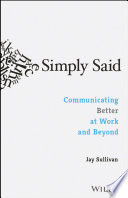

One of the foundational concepts of 'Simply Said' is the importance of clarity in communication. The book emphasizes that clear communication is essential for effective interaction, whether in personal or professional contexts. Clarity helps prevent misunderstandings and ensures that the intended message is conveyed accurately. The author discusses various techniques to achieve clarity, such as simplifying language, avoiding jargon, and structuring messages logically. By focusing on clarity, communicators can enhance their influence and ensure that their audience understands their points without confusion. The book provides practical examples and exercises that readers can use to practice and improve their communication skills, making clarity a tangible goal rather than an abstract concept.
Continue readingAnother key idea presented in 'Simply Said' is the power of brevity. The author argues that in a world inundated with information, being concise is crucial. Brevity not only respects the audience's time but also increases the likelihood that the message will be remembered. The book offers strategies for distilling complex ideas into succinct statements, encouraging readers to focus on the essential elements of their messages. This practice not only enhances comprehension but also engages the audience more effectively. The author provides examples of successful leaders and communicators who exemplify brevity in their messaging, illustrating how it can lead to greater impact and retention.
Continue readingThe book emphasizes the necessity of tailoring messages to the specific audience. Understanding the audience's needs, preferences, and backgrounds is critical for effective communication. 'Simply Said' discusses the importance of audience analysis and how it can shape the way messages are crafted. The author provides tools and frameworks to help readers assess their audience and adjust their communication style accordingly. By doing so, communicators can ensure that their messages resonate more deeply and are more likely to elicit the desired response. This idea highlights the dynamic nature of communication and the importance of adaptability in messaging.
Continue readingStorytelling is a powerful tool in communication, and 'Simply Said' highlights its significance. The author posits that stories are more relatable and memorable than abstract concepts or data. By weaving narratives into their communication, individuals can create emotional connections with their audience, making their messages more impactful. The book provides techniques for incorporating storytelling into various types of communication, whether in presentations, written reports, or casual conversations. This idea underscores the human aspect of communication and how stories can transcend barriers, making complex information more accessible.
Continue readingIn an increasingly visual world, 'Simply Said' discusses the importance of visual communication. The book explores how visuals can enhance understanding and retention of information. The author argues that integrating visuals—such as charts, graphs, and images—into communication can clarify complex ideas and engage the audience more effectively. Practical tips are provided on how to create effective visuals that complement verbal or written messages. This idea reflects the evolving nature of communication in the digital age, where visuals often play a crucial role in how messages are received and understood.
Continue readingFeedback is a vital component of effective communication, and 'Simply Said' emphasizes its role in continuous improvement. The author discusses how soliciting and incorporating feedback can enhance communication skills over time. Readers are encouraged to seek constructive criticism from peers and mentors, as this can provide insights into areas for improvement. The book outlines strategies for giving and receiving feedback effectively, fostering a culture of open communication. This idea highlights the importance of growth and adaptability in communication, encouraging readers to view feedback as a valuable tool rather than a criticism.
Continue readingTrust is a cornerstone of effective communication, and 'Simply Said' explores how communicators can build and maintain trust with their audience. The author discusses the importance of authenticity, transparency, and consistency in messaging. By being genuine and honest, communicators can foster a sense of trust that enhances their influence. The book provides examples of leaders who have successfully built trust through their communication practices, illustrating the long-term benefits of trust in relationships. This idea underscores the ethical dimension of communication, highlighting the responsibility communicators have to their audience.
Continue reading